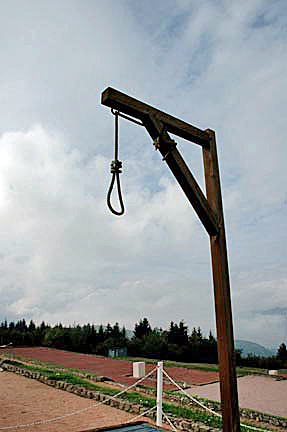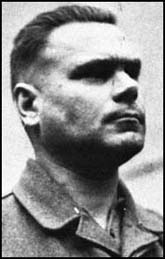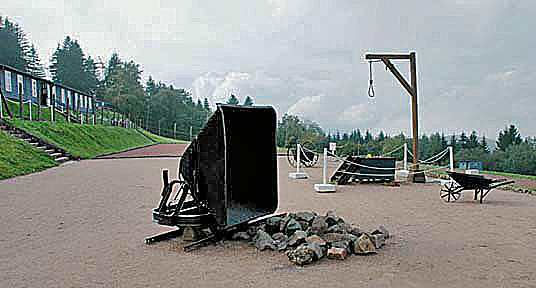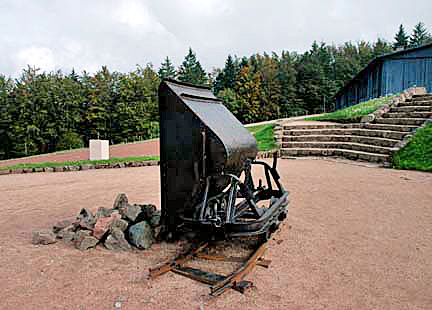Natzweiler-Struthof Gallows

Shown in the photo above is the gallows
where prisoners, who had been condemned to death, were hanged
at Natzweiler. In the background you can see the terraced hillside
where the barracks once stood. The hangman's noose was set up
whenever an execution was scheduled.
Some time after France was liberated
by the Allies, with the help of the French resistance fighters,
a gathering was held at the Natzweiler camp to honor the brave
men and women who had died for France. According to a book which
I purchased at the Memorial site, Professor Simonin, one of the
survivors, said the following words at the ceremony:
I can see Commandant Kramer up on
the platform with his S.S. sidemen, by the gallows, in front
of the convulsed body of a poor hanged man. I can see the vile
and grinning face who shouts, coldly, with unparalled scorn,
above the heads of the prisoners gathered in the yard: "I
wouldn't mind having you hanged, just like this one, one after
the other."
 Josef Kramer
Josef Kramer
Josef Kramer was the Commandant at Natzweiler
before he was transferred to Auschwitz and then to Bergen-Belsen.
He was brought before a British military tribunal after the war,
convicted, and hanged in December 1945.
In a book which I purchased at the Memorial
site, the following description of a hanging at Christmas time,
written by Docteur Ragot, one of the survivors, is quoted:
Christmas came, waking time was set
one hour later and we did not go to work in the afternoon for
two days in a row. Our kapo had changed two weeks before that,
and the new one was a German "green" that had been
detained for many years. A man of about fifty, he would lead
us roundly but he had the merit of being just.
As he had liked our sunday songs,
he asked us to organize something for Christmas Eve, and himself
decorated a fir tree with garlands and even with small candles.
There were to be some festivities consisting mainly of supplementary
food. There is no need to say that these were the ones that most
appealed to us. But there were to be others...
As early as noon, as we were coming
back from work, we were offered the first one. That is the way
the German mind is; mystical and infernal at the same time. Two
gallows were erected on the upper platform and two deportees
were hanged in front of all the prisoners: slow hanging by strangulation,
without letting the hanged man fall down; it takes him at least
two minutes to die.
When it was finished, we were marched
- Mützen ab - (caps off) five in a row, between the two
corpses on our left and the S.S. staff among whom Kramer was
sitting, with a cigar in his mouth; they enjoyed every bit of
it and watched for our reactions. We marched past them like automans,
unconcerned, our eyes in the vague, mostly thinking of the soup
that was waiting for us and that was getting cold in our mess
tins.
...it did not keep us from enjoying
our three potatoes served with a little bit of gravy a few minutes
later, or from singing and from playing music in the afternoon.
We lived, we died, we lived working, starving, but still hoping.
Alas we died, alone most of the time, without a friend to close
our eyes, without religious help for the believers; once the
pitiful corpses of the executed prisoners were burned, only their
memory would stay.
The photo below shows the area between
where two of the barrack buildings formerly stood. This is where
the prisoners were forced to watch public executions. In the
background on the left is Barrack No. 1 which is now a Museum.
The rose-colored area is where Barrack No. 2 formerly stood.
In the foreground is displayed a cart used on a narrow gauge
railroad to haul stones from the quarry where the prisoners were
forced to work in the early days of the camp. Later, the prisoners
worked in munitions factories. The second photo below shows another
view of the same cart.


In the photo above, the camp kitchen
is shown in the background on the right. In the background on
the left is a small white stone block. Each of the terraced spaces
where the barracks formerly stood has one of these blocks. They
are engraved with the names of other Nazi concentration camps
where Jews died in the Holocaust, such as Auschwitz, Majdanek,
and Bergen-Belsen. Although Natzweiler was not a death camp for
the extermination of the Jews, these blocks serve to link together
the atrocities of the Nazis.
|